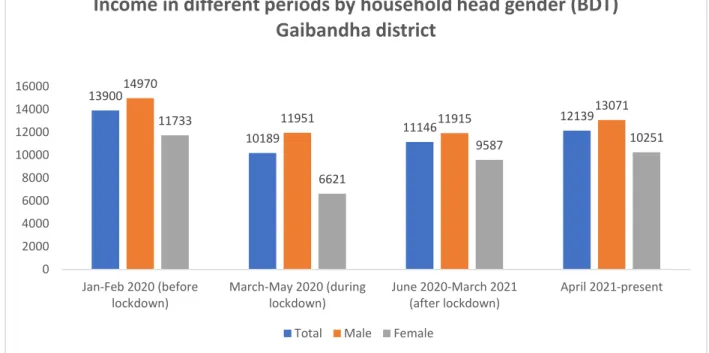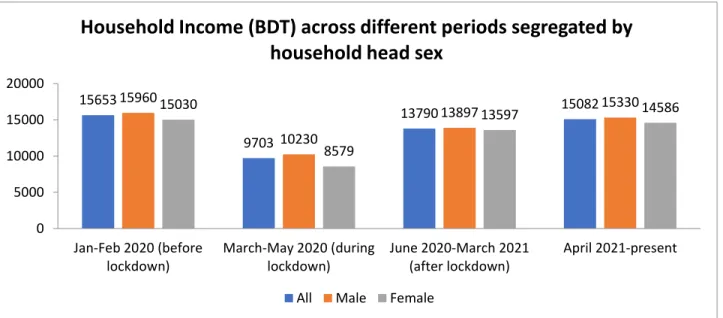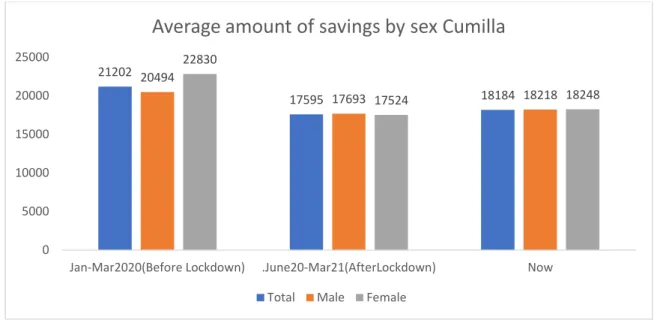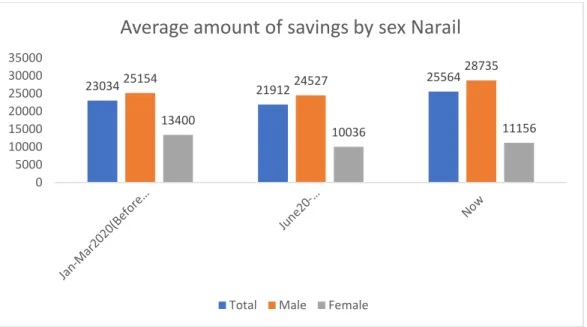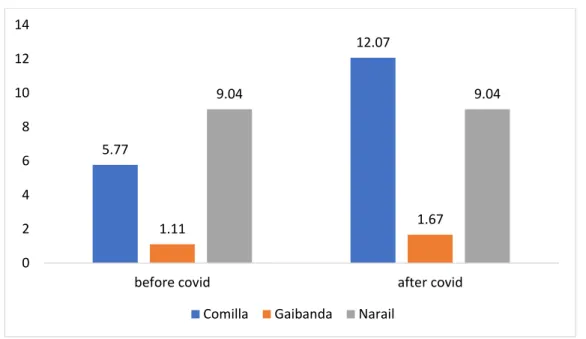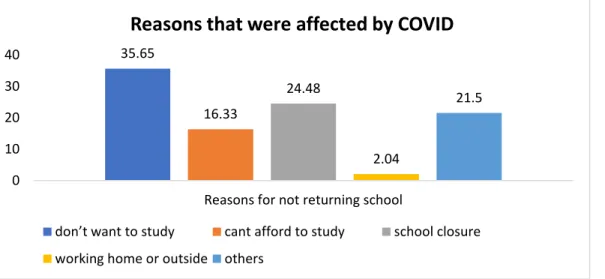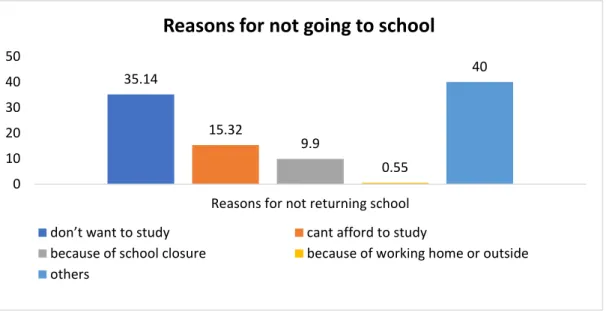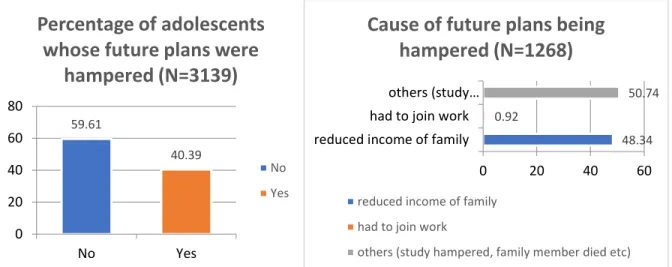This research, focusing on the impact of COVID-19 on life-related skills. Very few teenagers in the sample were involved in income-generating activities during pre-COVID-19 times.
Introduction
During the second wave of the pandemic in 2021, people's savings were depleted by 24% in rural areas and by 11% in urban areas. What are the implications for their vulnerability to risk and violence, now and in the future.
Research questions
What choices are/have been made/or are young women and their guardians considering regarding their future and whether these decisions lead them to greater vulnerability and thus threaten their current and future access to legal protection. What support mechanisms are available for – family, community, state, non-governmental organizations (NGOs) – and whether they meet their needs/are able to meet their needs.
Literature review
- Adolescent marriage
- Adolescent education
- Adolescent sexual and reproductive health
- Mental health and adolescence
- Child labour and adolescence
About 5% reported symptoms of moderate to severe depression, which was more common for older youth (Oakley et al., 2020). At least 80% of these youth also reported an increase in household stress since the onset of COVID-19 (Baird et al., 2020).
Methodology
Quantitative sample selection and data collection
27 A recent study by Educo Bangladesh reported that over 72% of the 940 child laborers surveyed said they had to work to support their families (Dhaka Tribune, 11 April 2021). A third of the children suffered physical injuries, 15% had mental health problems, 30% were verbal and 8% were physical.
Qualitative data collection
Key informants included the judge of the Shishu Adalat (juvenile court), the chairman or member of the UP; educational officer or school principal/mistress; the probation officer and the police officer (Child Specialized Police Desk) of the selected areas. The research team's legal advisor helped access the Shishu Adalat judge and the probation officer at Narail.
Challenges
To ensure that we were able to achieve the research objectives and ensure quality research results, we adapted the survey design. There are some questions that the father-in-law would not be able to answer and only the parents of the teenage member can answer.
Household and adolescent profile
Quantitative data
About 30% of the sample households have a female head and given the patriarchal social structure of Bangladesh, this seems intuitive. The education of the household head is a very important factor in shaping different aspects of a household.
Qualitative respondent profile
- Profile of in-depth interview respondents
- Profile of focus group discussion participants
Most of the surveyed young women were between 15 and 18 years old, only one 12-year-old, one 13-year-old and one 14-year-old. Ten of the young women interviewed were married (including one who is divorced and . currently engaged).
Findings
COVID-19 impact on household income, livelihood, and savings
- Changes in income/employment
- Changes in household food and non-food expenditure
- Food security
- Changes in savings and financial liabilities
- Loans
One of the male adolescents, whose father was a migrant worker and could send less money during the lockdown, said. The qualitative research found that the majority of households with adolescent food consumption had to be at risk during the COVID-19 pandemic.
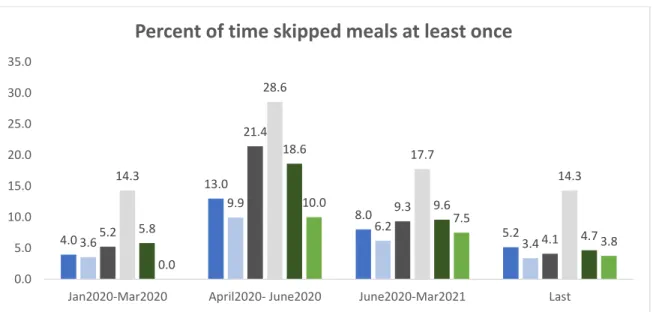
Education and COVID-19
- Continuation and changes after the onset of COVID-19
- Challenges to learning during COVID-19
- Choices/Decisions made by parents and adolescents
- Future aspirations
Of the remaining youth, 35% did not want to study, and 15% stated that they could not afford school. Young people were asked which of the reasons for not going to school were affected by COVID-19. Some young people felt that school closures meant they could help out at home, either financially or with household chores.
Average monthly cost rose sharply from its pre-pandemic level of BDT 606 to around BDT 660 during the initial days of the pandemic. For some, their educational aspirations have changed in light of the financial burdens their families have faced during the lockdown.
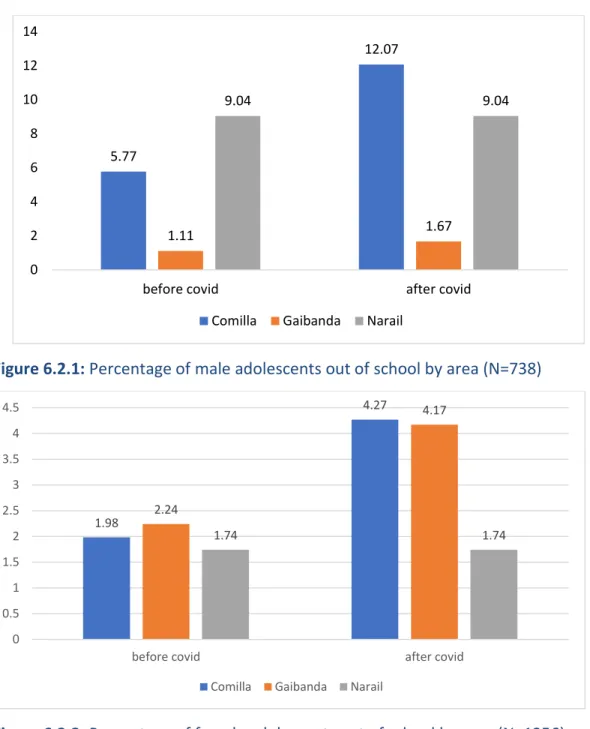
Adolescents’ work and COVID-19
- Changes during COVID-19
- Migration of adolescents for work
- Challenges of work
- Aspirations: Parents and adolescents
- Combining work and school
Among the five working boys, three dropped out of school and decided to work full time. Before the COVID-19 period, 84.35% of young people intended to continue their studies, and 13.49% wanted to work. In Cumilla, boys want to work in motor garages and metal workshops due to availability.
The results broken down by gender show that 0.40% of parents want their child to work in agriculture if their child is a man, compared to 1.75% for their female adolescents. More parents want their adolescents to work in jobs and businesses when their child is male compared to their female adolescents.
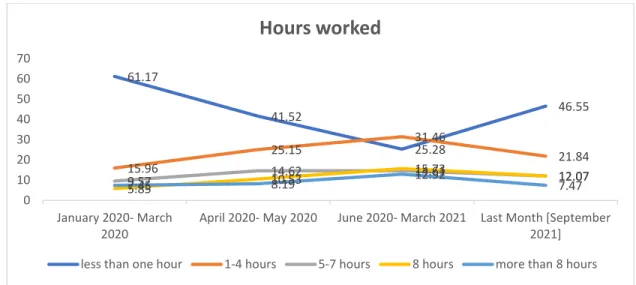
Adolescent marriage and COVID-19
- Prevalence and change in early marriage during/after COVID-19
- Choices/decisions made by parents and adolescents
- Expenditures for marriages
- Changes in the lives of adolescent girls due to marriage
- Challenges
- UP member's views on child marriage
- Combining marriage and education
- Aspirations: Parents and adolescents
The parents decided to marry off their daughters because of the school closure, leaving the adolescents at home with nothing to do but housework. Some adolescents wanted to respect their parents' wishes, and some did not want to damage their family's reputation by refusing marriage. The paternal households had to bear the costs of the adolescents and their children during the pandemic.
And some of the parents said that after marrying off their daughter, the expenses increased. One of the respondents did all the household work according to her mother-in-law's instructions.
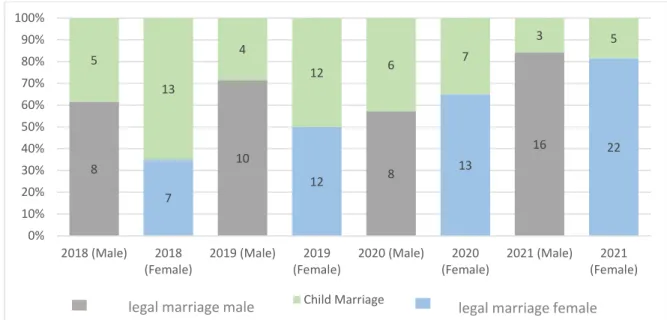
Social life and leisure
- Social interaction
- Use of cell phones and digital technology
The proportion of time spent up to one hour dropped relatively sharply from 63.59% to 50.90% during the first closure. When asked, teenagers with access to the Internet and smartphones (see appendix) answered that they do not know much about the risks of using technology, except for hacking into Facebook accounts. Those respondents with Internet access said they learned about COVID-19 through YouTube.
But when the relationship ends, boys can spread 'bad' photos of the girl on the internet". This is reflected in the drop during the first lockdown for those who thought cybercrime had decreased.
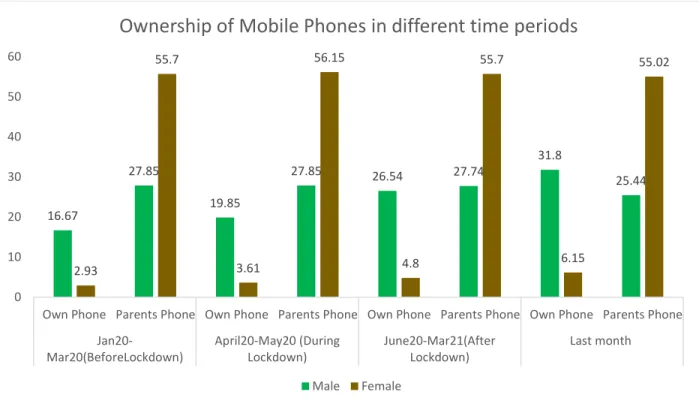
Psychosocial well-being
- Mental health effects related to COVID-19 pandemic lifestyle changes
- Adapting to stress
- Confidence and independence
- Support systems during COVID-19
- IDI and FGD findings
Similar to lack of sleep and loneliness, the level of frustration between young people during the quarantine due to COVID-19. The level of irritability/hopelessness increased during the COVID-19 quarantine and decreased again after the quarantine. However, the rate of adolescents who felt slightly suicidal and self-harming increased slightly during the COVID-19 quarantine and decreased again after the quarantine.
The rate went down after the COVID-19 lockdown, but still did not return to the previous rate. The number of hobbies is higher among female adolescents than among males, both before and after the COVID-19 period.
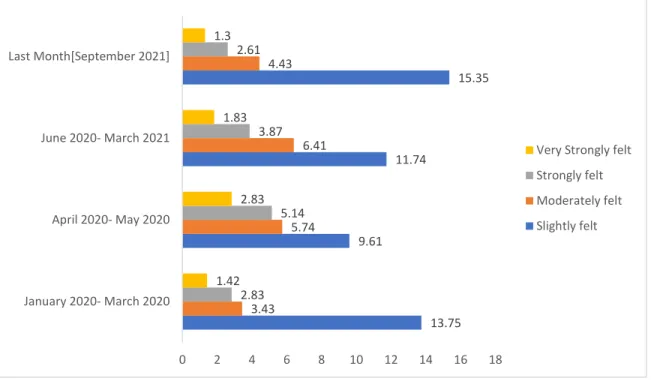
Violence and sexual harassment faced by adolescents
- Experiences of violence and abuse
- Violence and abuse inside the family
- Violence and abuse outside the family
When asked about physical violence by family members, 10.95% of adolescents overall reported being exposed to physical violence by family members during COVID-19, which was less than the 11.89% pre-COVID-19. However, verbal abuse increased during COVID-19 for both men and women compared to before the pandemic. Rates for sexual harassment by a family member during and after COVID-19 are less than 0.5% and not much variation was observed.
Rates of physical assault/abuse and sexual harassment by outsiders are higher than those from family. A higher percentage of women believe that harassment by a family member or a stranger is a criminal act, namely 33.01% compared to 2.13% of men.
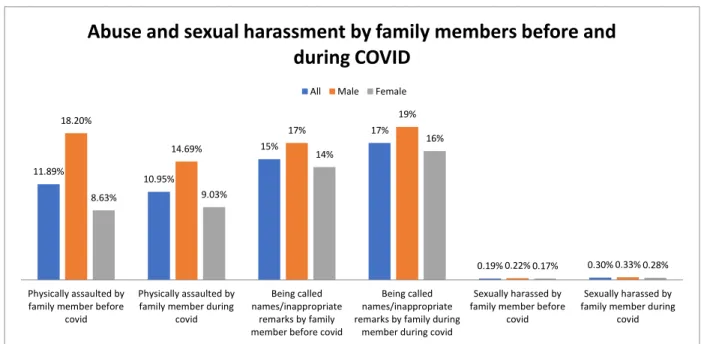
Other vulnerabilities and risks
- Drugs, trafficking, stealing, etc
- Vulnerabilities at the workplace
KII in Cumilla had mentioned gang violence between boys and it had been mentioned by some of the boys there. The Narail District Judge of the NSNDA Tribunal and Shishu Adalat cited the prevalence of gang violence among adolescent boys. The Narail District Judge of the NSNDA Tribunal and Shishu Adalat mentioned that the three neighboring districts of Jessore, Satkhira and Narail were prone to trafficking.
The Narail District Judge of the NSNDA Tribunal and Shishu Adalat mentioned that he had many cases related to the trafficking of women and children in his court. Workplace physical assault or sexual harassment rates are all generally below 3% for each of the periods shown above.
Access to justice and other services
- Awareness of regulations and the impact of their breach
- Adolescents’ knowledge and experiences of access to services
- Key informants’ perspectives on the impact of COVID-19 on adolescent conflict with
Similar to the legal age of marriage, female adolescents have better knowledge of the impact of child marriage. He had the feeling that most people with problems go to the TNO of that area. Several young people indicate that they are afraid of the consequences if they complain to the police about child marriage or sexual harassment.
Various respondents (DSS Probation Officer, Gaibandha and District Judge, Gaibandha) mentioned that the 2013 Act has increased police accountability. Granting bail to those children who come into conflict with the law was one of the top priorities.

Elicited parental perception
UP President of Bhorotkhali Union, Saghata Union, Gainbandha mentioned that domestic violence, child marriage and cases related to molestation are usually resolved by UP. The UP member of Narail (Joypur Union, Lohagora Upazila) also highlighted his role in providing justice to the residents of his constituency. If the president of the UP could not solve the problem then they would turn to the local matbars (leaders).
The UP member in Narail (Joypur Union, Lohagora Upazila) also said they played a role in "monitoring" the young men in the area to make sure they behaved and didn't get into trouble, did not have gaja (weed), alcohol or fensedyl (popularly abused drug). The UP member in Narail (Joypur Union, Lohagora Upazila) highlighted the UP's role in distributing aid during the COVID-19 pandemic.
Conclusions and recommendations
Conclusion
लेयत पायर" which translates to "In times of financial crisis, child marriage is fine if a good enough proposal is received." It is clear from the figure that when the answer is drawn whether child marriage is acceptable varies significantly. They believe that the crisis financial, a good marriage proposal, or even opportunities for financial gain are justifiable reasons for marrying their children, especially their daughters.
Recommendations
- Recommendation one: Addressing vulnerabilities to make adolescent lives safe and
- Recommendation two: Strengthening responsive and adolescent-friendly support
- Recommendation three: Strengthening governance and ensuring accountability of
Strengthening the role of school teachers and child marriage prevention committees in preventing early marriages and promoting social interactions between the sexes. Accountability of those who have an official role in preventing child marriage, such as Kazis and members of the UP and Chairmen and Committees for the Protection of Child Marriage, for allowing child marriage. Buchmann, Nina; Field, Erica; Glennerster, Rachel; Nazneen, Shahana; Pimkina, Svetlana; Sen, Iman (2018), Effect of conditional incentives and a girls' empowerment curriculum on adolescent marriage, birth and education in rural Bangladesh: a cluster randomized controlled trial. 2004). The socio-cultural context of child marriage in a Bangladeshi village.
Mostafa; Hassan, Che Hashim; Alam, Gazi Mahabubul; Ying, Yang (2015), Child marriage in Bangladesh: trends and determinants, Pages 120-139, Issue 1, Volume 47, Journal of Biosocial Science, PubMed. Malhotra, Anju; Elnakib, Shatha Years of Evidence on What Works to Prevent Child Marriage: A Systematic Review.
